history of shaw farms
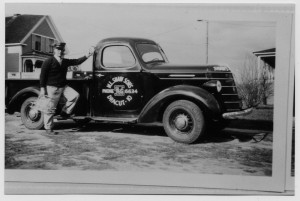 In 1908 Henry Ford introduced his Model T Ford, the nation celebrated its first official Mother’s Day, and Mark Loran Shaw, Sr., purchased a piece of land that most people thought to be useless. It was mostly swamp and woods, but with the addition of another parcel extending from Hildreth St. to New Boston Road, the Shaw Farm birthed its early beginnings.
In 1908 Henry Ford introduced his Model T Ford, the nation celebrated its first official Mother’s Day, and Mark Loran Shaw, Sr., purchased a piece of land that most people thought to be useless. It was mostly swamp and woods, but with the addition of another parcel extending from Hildreth St. to New Boston Road, the Shaw Farm birthed its early beginnings.
2008 marked the 100 year anniversary of that bold step and the legacy of vision, determination, and hard work begun so long ago. The Earliest Beginnings When the King of England offered farm land to New England Farmers in the 1700’s, the Shaws, living in Rhode Island, moved to Nova Scotia. Living in Lockhart, Nova Scotia, then 15-year-old Mark L. Shaw made the decision to leave home in pursuit of his dreams. He enrolled in the Acacia Villa Schools for Boys and after two years headed back to the United States. After working on farms in Massachusetts, he found work at the Oliver J. Coburn farm in Dracut for several years, and eventually settled on Hamblett Avenue in Dracut, where he married, began to raise a family, and opened and operated a bakery until the early 1900’s. Dracut was a very primitive town in the early 1900’s, no police, a volunteer fire department and an economy dominated by the Merrimack Woolen Mills.
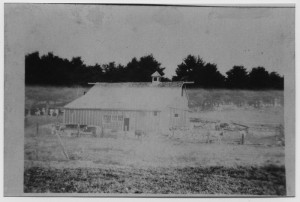 In 1908 records indicate that weavers were on strike for better wages. It was during this time that Mark L. Shaw, Sr. and his wife Annie purchased the first parcel of land on 195 New Boston Road. In a short period of time, he had built a home, a barn and a milk house. In these early years, the family worked off-farm jobs in addition to their family farm work, a family that would include their three children, Mark Loran, Jr., Albert, and Gladys. An Opportunity In 1912 at the age of 21, Mark Shaw, Jr., took a job off the farm driving a milk wagon for the Oliver J Coburn Farm, a place his father had worked some 24 years earlier. Family records indicate he earned $12.00 for the week’s work. Despite this modest wage he was able to purchase additional property on New Boston Road to expand the family farm. The job with the Coburns lasted a little more than two years.
In 1908 records indicate that weavers were on strike for better wages. It was during this time that Mark L. Shaw, Sr. and his wife Annie purchased the first parcel of land on 195 New Boston Road. In a short period of time, he had built a home, a barn and a milk house. In these early years, the family worked off-farm jobs in addition to their family farm work, a family that would include their three children, Mark Loran, Jr., Albert, and Gladys. An Opportunity In 1912 at the age of 21, Mark Shaw, Jr., took a job off the farm driving a milk wagon for the Oliver J Coburn Farm, a place his father had worked some 24 years earlier. Family records indicate he earned $12.00 for the week’s work. Despite this modest wage he was able to purchase additional property on New Boston Road to expand the family farm. The job with the Coburns lasted a little more than two years. In the spring of 1915, disaster stuck at the Coburn Farm when the entire herd of cows had to be destroyed as a result of “foot and mouth disease.” This misfortune led to the demise of the Oliver J Coburn Farm which was the site of the current Dracut Historical Society building, the Dracut School Complex and the former police station. The Coburn Farm was sold at auction in 1933, most of the land going to the Justus Richardson Farm. For his dedicated service, Mark Shaw was offered the opportunity of keeping the Coburn home delivery customers. He was successful in keeping most of the customers which became the beginning of the M.L.Shaw and Sons milk delivery business.
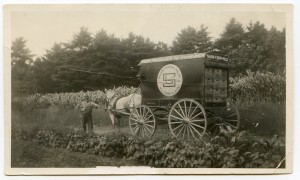 With this new retail business, the family, members were able to dedicate all of their efforts to the family farm. A new building for bottling was constructed; more cows were purchased; and a very primitive bottling operation began. They burned wood under a farmer’s kettle to make hot water, washed bottles by hand and filled them out of an eight quart can. All milking was done by hand, cooled with water, and then cooled with ice in the bottling plant. Ice had to be purchased each day. During the summer of 1915, Mark Shaw, Jr. began to build a home on the farm. On a cold February night in 1916, having built enough of it to live in, he and Sarah Grace Haslam walked to the home of Reverend Samuel Dupertius to be married. The honeymoon lasted until four A.M. the next morning when he returned to his delivery route. They would have three children, Eleanor (1918), Winthrop (1921), and Warren(1924). From Horse-drawn Wagon to Milk Truck Until 1927, all of the milk was delivered by a horse-drawn wagon, pulled by a horse named Prince.
With this new retail business, the family, members were able to dedicate all of their efforts to the family farm. A new building for bottling was constructed; more cows were purchased; and a very primitive bottling operation began. They burned wood under a farmer’s kettle to make hot water, washed bottles by hand and filled them out of an eight quart can. All milking was done by hand, cooled with water, and then cooled with ice in the bottling plant. Ice had to be purchased each day. During the summer of 1915, Mark Shaw, Jr. began to build a home on the farm. On a cold February night in 1916, having built enough of it to live in, he and Sarah Grace Haslam walked to the home of Reverend Samuel Dupertius to be married. The honeymoon lasted until four A.M. the next morning when he returned to his delivery route. They would have three children, Eleanor (1918), Winthrop (1921), and Warren(1924). From Horse-drawn Wagon to Milk Truck Until 1927, all of the milk was delivered by a horse-drawn wagon, pulled by a horse named Prince. 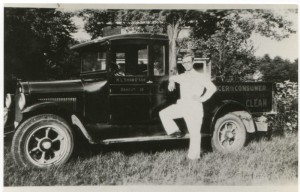 In 1927 Prince was replaced with a Graham Dodge truck. All seemed to be going well until the events of October 28th, 1929, when the stock market crashed. Banks began to close, eventually resulting in milk bills going unpaid. Many local businesses shut down during the Depression, but the farm kept operating. Some customers who were unable to pay their bills, compensated by providing farm labor. Buildings were repaired, land reclaimed, and drainage work done with this additional farm labor. Although the farm was far from profitable during these years, it provided food for the families.
In 1927 Prince was replaced with a Graham Dodge truck. All seemed to be going well until the events of October 28th, 1929, when the stock market crashed. Banks began to close, eventually resulting in milk bills going unpaid. Many local businesses shut down during the Depression, but the farm kept operating. Some customers who were unable to pay their bills, compensated by providing farm labor. Buildings were repaired, land reclaimed, and drainage work done with this additional farm labor. Although the farm was far from profitable during these years, it provided food for the families. The Next Generation and Beyond When M.L. Shaw, Sr. passed away in 1933 at the age of 77, his two sons, Mark L. and Albert renamed the farm ML Shaw Sons to honor their father. The sons continued to operate the farm as a home-delivery dairy. In the 1930’s, home delivery of milk became a very competitive business. HP Hood Company began to have their route salesmen follow greater Lowell independent dairies with the intent of capturing their accounts. The Hood representative would offer customers free milk for one month making it difficult for the independent to hold onto his accounts. The Shaw Farm routes were spared this treatment as a result of a friendship the Hood representative had with Albert Shaw, who had taken over responsibility for the route sales as well as processing. In the late 30’s with the Depression in the past, the farm began to return to profitability. The horse era ended with the purchase of gasoline-powered tractors.
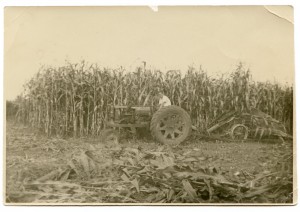 The Farmall F-12 and Farmall H were the popular tractors of the era and several were purchased by the Shaws. In1938, there was a big hurricane that hit New England. Read about it here: LINK The farm lost some 200 trees to the storm. The trees were brought to a local sawmill, and turned into lumber, and in turn used to build many of the current buildings, still in use. The farm continued to grow into the 40’s as Winthrop and Warren Shaw began to play important roles. Winthrop, and his wife Virginia purchased a farm located on Hildreth Street. This parcel of land was owned by Delmont Coburn and produced corn for silage.. In 1949, Winthrop Shaw left the farm, relocating to California as a result of a severe case of asthma. M.L. Shaw, Sr., his brother Albert, and son Warren along with several other key people continued to work the farm.
The Farmall F-12 and Farmall H were the popular tractors of the era and several were purchased by the Shaws. In1938, there was a big hurricane that hit New England. Read about it here: LINK The farm lost some 200 trees to the storm. The trees were brought to a local sawmill, and turned into lumber, and in turn used to build many of the current buildings, still in use. The farm continued to grow into the 40’s as Winthrop and Warren Shaw began to play important roles. Winthrop, and his wife Virginia purchased a farm located on Hildreth Street. This parcel of land was owned by Delmont Coburn and produced corn for silage.. In 1949, Winthrop Shaw left the farm, relocating to California as a result of a severe case of asthma. M.L. Shaw, Sr., his brother Albert, and son Warren along with several other key people continued to work the farm. In 1944 the farm was awarded the Agricultural Pennant for war time production of milk by the Massachusetts Society for the Promotion of Agriculture. In 1947 Warren married Nancy Kinports and later built a home at 251 New Boston Rd, and would have four children, Ruth, Linda, Warren, Jr., and Susan. In 1949, Walter Biedron of Old Rd took a part time job “jumping” on the milk routes, working with Albert Shaw. He never left. Over the years, he would make the gradual transition from route jumper to milk processing manager and claims to have handled over a million bottles during that time. Biedron oversaw the change of a manual bottling operation, where he started each day loading a wood fired boiler, to a modern steam powered pasteurization plant.
For many years, he started each day leaving the farm with a delivery truck, and finished by processing and bottling the day’s milk production. This man worked as hard, and was as dedicated as any family member. For his hard work, Mark L Shaw gave him a lot of land on the farm to build his home. He and his wife Barbara had four children, one of them, Walter Biedron, Jr., who would also make a career of the farm. He continued to work full time until 1994, and to this day acts as a consultant to current plant manager Jim Sheridan. In total, he gave over 55 years to the farm. It was in the late 50’s that Mark L Shaw, Jr. retired from the family business, leaving ownership to Albert Shaw and Warren L Shaw.
The challenge of the 1960’s would become supermarkets. Home delivery of milk, long the backbone of the business, began to decline as consumers were attracted to the one-stop convenience of these new markets. Through the early 60’s the farm experienced difficult financial times as home delivery sales declined and margins decreased due to the competitive pricing of the large markets. During this period, throughout New England, small farms with on-farm bottling succumbed to the financial pressure, and sold their farms for development. Committed to the future of the farm, Warren Shaw began to realize that a new vision was necessary for the farm to continue. He had spent his entire working life on the agricultural side of the business but knew that with Albert getting close to retirement, he would have to take leadership for a new marketing strategy He found his strategy in on-farm sales.
Customers Respond Never one to borrow money or spend large sums, Warren’s approach was to provide a simple, inexpensive way for local folks to stop by the farm and pick up their milk. Without the resources to build a new store, or to pay someone to oversee sales, he decided to trust the honesty of potential customers and use an honor system. A cooler in the back of what had been the milk truck garage, with a 40 quart milk jug and a slot cut into the cover, became the beginning of the Shaw Farm Store. For several years the little milk jug handled lots of cash, so much so that as sales grew, he had to think about a more formal store and full time clerks. In 1968, the “garage” was closed in, doors cut into the walk-in cooler for customer access, and a counter made for a store clerk to work from. It all worked, and customers loved it. A Few Goodbyes In 1973, Albert Shaw retired and Warren’s wife Nancy left her job as a cafeteria worker in the Dracut Schools and assumed Albert’s bookkeeping responsibilities and store management.
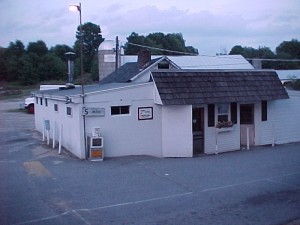 At about the same time Warren ,Shaw Jr. and Walter Biedron, Jr. became full time employees of the farm. In 1975 Mark Shaw, Jr. passed away. His life long commitment to the farm was felt by all who attended his services as he had left instructions for his funeral precession to pass through the store drive way and stop for a moment of reflection. He is buried along with other Shaw family members on the edge of the farm Several small additions were built to the store and to the bottling plant during the late 70’s and early 80′s as sales in the new store continued to grow. Fat free milk sales began to grow at about this time, and a market had to be found for the cream.
At about the same time Warren ,Shaw Jr. and Walter Biedron, Jr. became full time employees of the farm. In 1975 Mark Shaw, Jr. passed away. His life long commitment to the farm was felt by all who attended his services as he had left instructions for his funeral precession to pass through the store drive way and stop for a moment of reflection. He is buried along with other Shaw family members on the edge of the farm Several small additions were built to the store and to the bottling plant during the late 70’s and early 80′s as sales in the new store continued to grow. Fat free milk sales began to grow at about this time, and a market had to be found for the cream. Albert Shaw passed away in 1982 having sold his share of the business to Warren Sr. For an entire lifetime he had overseen the processing and delivering of Shaw Farm products along with the responsibility of paying the bills. Favorite Flavors (or What to Do with All That Cream!) The obvious answer to the cream surplus issue was found in ice cream. Although the family has vast experience in milk production and processing, ice cream was an entirely different product. Research of this new challenge would take over a year. Warren Sr, Nancy, and Warren Jr. spent their available time learning about ice cream mix production, flavoring, and availability of equipment. In the end, used Emery Thompson batch freezers were purchased second-hand and an ice cream formula was freely given by the owner of another dairy—Peaceful Meadow Dairy.
One of the unique qualities most dairy farmers have is the willingness to share knowledge. Ice cream sales grew rapidly, and many new flavors were added yearly. Nancy and Warren spent many mornings beginning at five A.M. making flavor after flavor of delicious homemade ice cream. This new value-added product would make it possible to add an ice cream stand to the farm later in the 90’s. Self-Sufficiency During the growth years of the 80’s, the farm had purchased additional milk supplies from other farms to balance milk supply and sales. Warren Jr., now managing the farm in the 90’s, became concerned that this supply would soon disappear. A plan was developed to become self sufficient by having, first, the capacity to haul milk independently from other farms and later build a new cow facility to house enough cows to supply 100% of the milk. Also, additional land would be required to produce the needed corn, grass and hay. By the year 2000, the farm was self-sufficient. A new 60 cow addition was added with comfort stalls and modern air handling equipment, the original barn was modified, and Walter Biedron, Jr. became the herdsman for one of the best herds in the state. The position of herdsman is a very high skilled position and “Wally” has become one of the best in the industry. The barn has space for 100 cows.
The Pomerleau farm was purchased on Marsh Hill, adding 50 acres to the land base, and lease arrangements taken on 80 acres of Wilson farm land in Litchfield, New Hampshire and numerous smaller parcels in Dracut and Pelham, NH. To acquire the Pomerleau Farm, an APR agricultural preservation restriction easement was sold to the Commonwealth of Massachusetts on 50 acres of the “home farm”, along with 16 acres of the Pomerleau property. This money was used to acquire the new land. The 90′s saw many farm improvements including a covered, concrete manure storage building and, an equipment storage building and a new bunker silo, along with many equipment replacement purchases. The year 2000, brought change in the sales area. Because of the popularity of Shaw Farm’s homemade ice cream, we moved in the direction of a traditional New England ice cream stand, constructed on the farm.
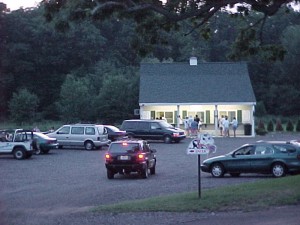 The stand continued to be busy selling ice cream cones and sundaes from April through November. On July 31, 2003, Warren Shaw, Sr. passed away at the age of 79. He lived a clean, honest life and spent a life time of dedication to Nancy, his children and the farm. He brought the farm through a period of change in the industry that found most small dairy farms selling out to development. The on-farm retail business he created became the economic engine that funded many of the projects done later. Warren spent his last days watching these improvements come to life. In 2007 Shaw Farm began to market its own “certified organic” milk products under the name New England Organic Creamery. Changes in the marketplace driven by consumer demand for local organic milk have made this change important to the future of the farm. After a year of establishing this new brand, organic sales have begun to grow rapidly, with Wilson Farms, and Whole Foods Markets continuing to sell lots of this new product line. The Future Although much has changed in our long 100 year history, one thing has remained constant. The farm continues to be driven by the family legacy of vision, hard work and determination begun so many years ago by M.L. Shaw, Sr. Nancy is still with us and continues to contribute on a regular basis. Her collaboration with sister Susan on flower garden arrangements keeps us looking great during the growing season.
The stand continued to be busy selling ice cream cones and sundaes from April through November. On July 31, 2003, Warren Shaw, Sr. passed away at the age of 79. He lived a clean, honest life and spent a life time of dedication to Nancy, his children and the farm. He brought the farm through a period of change in the industry that found most small dairy farms selling out to development. The on-farm retail business he created became the economic engine that funded many of the projects done later. Warren spent his last days watching these improvements come to life. In 2007 Shaw Farm began to market its own “certified organic” milk products under the name New England Organic Creamery. Changes in the marketplace driven by consumer demand for local organic milk have made this change important to the future of the farm. After a year of establishing this new brand, organic sales have begun to grow rapidly, with Wilson Farms, and Whole Foods Markets continuing to sell lots of this new product line. The Future Although much has changed in our long 100 year history, one thing has remained constant. The farm continues to be driven by the family legacy of vision, hard work and determination begun so many years ago by M.L. Shaw, Sr. Nancy is still with us and continues to contribute on a regular basis. Her collaboration with sister Susan on flower garden arrangements keeps us looking great during the growing season. Another sister, Ruth is always involved with ideas for retail improvements Winthrop Shaw, living in California, provided most of the early history of Shaw Farm for this story The Biedron family is as much a part of the farm, past and future as we are. Walter Sr. still comes to the farm every day to check on us. Wally Jr. has full responsibility for the herd and none of us would want to do this without him. Several other members of their family have also made significant contributions to the farm. Mark Shaw who now represents the fifth generation of Shaws on the farm is making his presence felt, and has made the commitment to keep the old girl going. Robert Pratt, husband of Sarah Shaw is now with us and is responsible for ice cream manufacture as well as taking part in milk plant duties. Sarah Pratt and Faith Shaw keep the books straight. Lyndie, along with her husband own and operate ML Shaw’s Country Kitchen a business started by Warren Jr. and Ruth. And Laurie Shaw, a retail professional, has assisted with the planning for the 100th celebration Many others play vital roles in the success of Shaw Farm.
Jim Sheridan, current milk plant manager has been with us since the age of 15 and is one of the best in the business. Future is now The years following the 100th anniversary celebration became a time of major change . 2008 saw the planning stages of what would be the biggest construction project in the Farm’s history. A new bottling facility was needed to allow for growth and to provide a modern environment for food safety, and a new retail facility was needed to allow growth in retail sales. Two grants were received from the Massachusetts Department of Agricultural . An agricultural innovation grant was received to help with the costs of developing a modern up dated on farm processing facility and a second grant was received from a program designed to help with the economic viability of farms. The farm also received a small federal grant for using renewable energy to heat and air condition the new building In addition to these grant funds we were fortunate to have the trust and support of First Pioneer Farm credit , the agricultural lender that financed the project In April of 2009, we broke ground on the new building project and by Columbus day weekend of that year, we opened the new farm store . The store connects to the ice cream stand allowing for ice cream service in an indoor seating area.
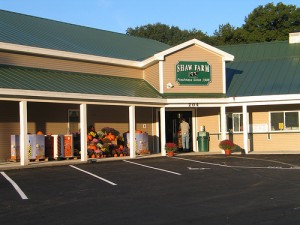 The store also has bakery products, produce and many more new products not available in the old store. On December 19th of 2009 we moved into our new modern bottling facility in the new building giving us the most up to date milk processing facility on a farm in New England. On November 1 of 2010 the old bottling facility and farm store was demolished to make room for over flow parking. Shaw farm now has its 6th generation family member working. Matt Zolkos, son of Lyndie and Jay has begun working on the farm part time as he goes to school and seems to enjoy it.
The store also has bakery products, produce and many more new products not available in the old store. On December 19th of 2009 we moved into our new modern bottling facility in the new building giving us the most up to date milk processing facility on a farm in New England. On November 1 of 2010 the old bottling facility and farm store was demolished to make room for over flow parking. Shaw farm now has its 6th generation family member working. Matt Zolkos, son of Lyndie and Jay has begun working on the farm part time as he goes to school and seems to enjoy it.







